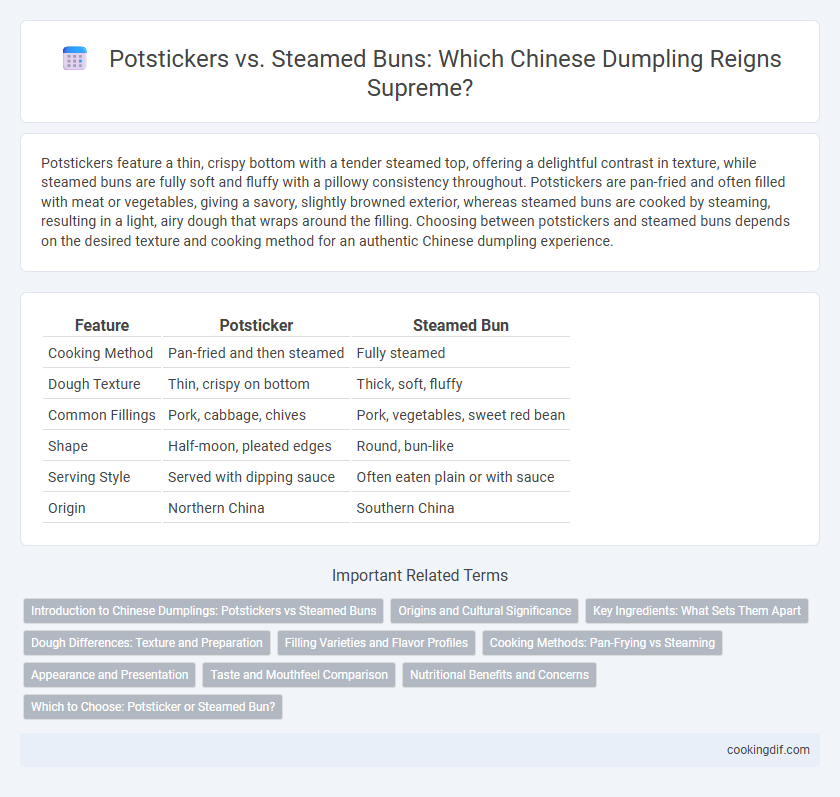Potstickers feature a thin, crispy bottom with a tender steamed top, offering a delightful contrast in texture, while steamed buns are fully soft and fluffy with a pillowy consistency throughout. Potstickers are pan-fried and often filled with meat or vegetables, giving a savory, slightly browned exterior, whereas steamed buns are cooked by steaming, resulting in a light, airy dough that wraps around the filling. Choosing between potstickers and steamed buns depends on the desired texture and cooking method for an authentic Chinese dumpling experience.
Table of Comparison
| Feature | Potsticker | Steamed Bun |
|---|---|---|
| Cooking Method | Pan-fried and then steamed | Fully steamed |
| Dough Texture | Thin, crispy on bottom | Thick, soft, fluffy |
| Common Fillings | Pork, cabbage, chives | Pork, vegetables, sweet red bean |
| Shape | Half-moon, pleated edges | Round, bun-like |
| Serving Style | Served with dipping sauce | Often eaten plain or with sauce |
| Origin | Northern China | Southern China |
Introduction to Chinese Dumplings: Potstickers vs Steamed Buns
Chinese dumplings showcase diverse textures and flavors, with potstickers offering a crisp, pan-fried bottom and tender steamed top, typically filled with pork and cabbage. Steamed buns, or baozi, feature a soft, fluffy exterior encasing savory or sweet fillings like char siu pork or red bean paste. Both variations highlight regional culinary traditions, emphasizing different cooking methods and ingredient combinations unique to Chinese cuisine.
Origins and Cultural Significance
Potstickers, originating from northern China, are pan-fried dumplings known as jiaozi, traditionally prepared during the Lunar New Year to symbolize wealth and prosperity. Steamed buns, or baozi, trace back to the Three Kingdoms period and serve as a staple street food with varied fillings representing regional flavors and communal gatherings. Both dishes embody distinct culinary traditions and hold deep cultural significance in Chinese cuisine.
Key Ingredients: What Sets Them Apart
Potstickers feature a thin, wheat-based wrapper filled with a mixture of ground pork, cabbage, ginger, and garlic, giving them a savory and slightly crunchy texture when pan-fried. Steamed buns, often called baozi, use a thicker, yeast-leavened dough that creates a soft, fluffy exterior filled with ingredients like seasoned pork, vegetables, or sweet bean paste. The key distinction lies in the wrapper's texture and preparation method, which directly influences the overall flavor and mouthfeel of each dumpling variety.
Dough Differences: Texture and Preparation
Potstickers feature a thinner, unleavened dough that crisps golden brown when pan-fried, creating a chewy yet crunchy texture, while steamed buns use a thicker, leavened dough that becomes soft and fluffy after steaming. The preparation of potsticker dough involves rolling out a simple flour-and-water mix to achieve an even, delicate wrapper ideal for frying or boiling. Steamed bun dough requires a yeast or baking powder leavening process, producing a pillowy exterior that envelops the filling in a light, airy bite.
Filling Varieties and Flavor Profiles
Potstickers feature a thin, crispy wrapper encasing a savory filling often made from ground pork, cabbage, and ginger, offering a balanced umami flavor with a hint of garlic. Steamed buns, also known as baozi, have a thick, fluffy dough surrounding fillings that range from succulent barbecue pork (char siu) to sweet red bean paste, creating a rich, moist taste experience. The contrast in texture and flavor intensity between potstickers' pan-fried crispiness and steamed buns' soft, pillowy exterior highlights diverse culinary preferences in Chinese dumpling cuisine.
Cooking Methods: Pan-Frying vs Steaming
Potstickers are pan-fried dumplings characterized by a crispy, golden-brown bottom and a tender, steamed top, achieved through a unique cooking method that starts with frying then steaming in the same pan. Steamed buns undergo a solely steaming process, resulting in a soft, fluffy texture with a moist interior, preserving the dough's lightness and the filling's juiciness. The choice between potsticker and steamed bun cooking methods significantly impacts texture and taste, with pan-frying offering a contrasting crunch and steaming providing consistent softness.
Appearance and Presentation
Potstickers showcase a golden-brown, crispy bottom with pleated, semi-translucent tops, offering a visually appealing contrast in texture. Steamed buns feature a smooth, white, and fluffy exterior with a rounded, pillow-like shape that emphasizes softness and simplicity. The presentation of potstickers often highlights their pan-fried crispiness arranged in a neat row, while steamed buns are usually served in bamboo steamers, enhancing their traditional and delicate appearance.
Taste and Mouthfeel Comparison
Potstickers offer a crispy, golden-brown exterior with a chewy texture that contrasts the juicy, flavorful filling, creating a satisfying bite that combines crispiness and tenderness. Steamed buns feature a soft, fluffy, and pillowy dough that envelops the savory or sweet filling, resulting in a gentle, moist mouthfeel that highlights the filling's richness and moisture. The choice between potsticker and steamed bun depends on preference for texture: potstickers deliver a multi-textural experience, while steamed buns provide a smooth, airy softness.
Nutritional Benefits and Concerns
Potstickers typically contain a lower fat content compared to steamed buns, as they are pan-fried with minimal oil, offering a good source of protein and moderate carbohydrates. Steamed buns, often larger and doughier, provide more calories and carbohydrates due to their thicker dough, which may affect blood sugar levels for sensitive individuals. Both options provide essential nutrients, but potstickers are generally preferred for lower calorie intake, while steamed buns offer a more filling option with potentially higher sodium depending on the filling.
Which to Choose: Potsticker or Steamed Bun?
Potstickers offer a crispy, pan-fried texture with a savory filling, making them ideal for those who enjoy a combination of crunch and juiciness. Steamed buns provide a soft, fluffy exterior with a warm, moist interior, perfect for savoring tender, flavorful dumplings. Choosing between potstickers and steamed buns depends on whether you prefer a crisp finish or a pillowy softness in your Chinese dumpling experience.
Potsticker vs Steamed bun for Chinese dumplings Infographic

 cookingdif.com
cookingdif.com